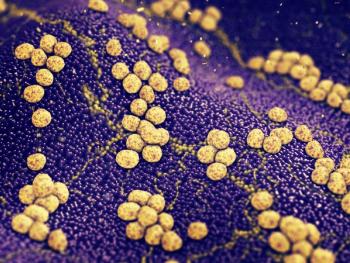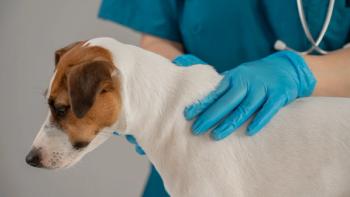
Cutaneous cytology: A quick review of an indispensable test
Cutaneous cytology immediately and inexpensively reveals whether infectious, inflammatory, or neoplastic processes are affecting the skin, and it can help you determine which diagnostic path to continue on.
Cutaneous cytology immediately and inexpensively reveals whether infectious, inflammatory, or neoplastic processes are affecting the skin, and it can help you determine which diagnostic path to continue on. For example, finding atypical cells will generally lead you to perform a skin biopsy for histologic evaluation.
Wayne Rosenkrantz, DVM, DACVD
To use this invaluable tool, you'll need a basic knowledge of sample collection techniques and keratinocyte morphology. And you'll need to know how to identify infectious organisms, inflammatory cells, and artifacts. Cytologic evaluation is most useful in identifying inflammatory or infectious processes. Interpreting samples obtained from neoplastic lesions requires specialized training, but tumors such as those involving mast cells can readily be detected. An easy way to expand your cytologic evaluation skills in practice is to obtain duplicate samples—one to read in-house and one to submit to a clinical pathologist—for comparative interpretation.
THE RIGHT TOOLS
The most important piece of equipment is a good-quality, well-maintained binocular microscope with a halogen light source and multiple objectives (4X, 10X, 40X, and oil immersion 100X). Different types of immersion oil are available, but I recommend type B for its versatility and high quality.
For simplicity, use a commercial modified Wright's stain such as Diff-Quik (Dade Behring), but keep in mind that it gives less nuclear detail than a vital stain such as new methylene blue. In my practice, we rarely perform Gram stains because of the time commitment and because differentiating gram-negative vs. gram-positive organisms usually does not change our immediate clinical decisions. Many other special stains are available through your clinical pathology laboratory. Keep the stain clean—change staining tubs weekly, and use separate containers for contaminated samples such as anal gland or fecal cytology.
Heat fixation can be accomplished with a blow dryer, Bunsen burner, lighter, or match. Heat fixation prevents sample loss from the slide during the staining process, especially samples that are waxy, greasy, or exudative. Hold the sample over a flame for only a few seconds to avoid overheating and damaging the sample.
SAMPLING TECHNIQUES
Direct impression
The easiest and often the most effective way to obtain a sample for cutaneous cytologic examination is a direct impression with a glass slide. Either press the glass slide against the site you want to sample, or place it at a slight angle to the skin surface and then scrape the skin surface while dragging the slide onto the abraded surface you have created. This latter technique may increase the amount of material you collect, but it also can damage some of the inflammatory cells, creating proteinaceous nuclear strands.
Transparent acetate tape
Use transparent acetate tape to collect material from dry lesions that will not readily stick to a glass slide or to reach areas that are challenging to sample with a glass slide. With this technique, do not perform heat fixation, and omit the Diff-Quik fixation (clear) solution step because the tape will not lie flat on the slide. Put one drop of the third solution (the purple stain) or a drop of new methylene blue onto a glass slide, and then apply the unstained tape preparation directly over the stain. You can examine these samples with all of the objectives (including oil immersion).
Fine-needle aspiration
Use syringes and needles to aspirate material from nodules, tumors, plaques, abscesses, or other lesions in which a deep (nonsurface) sample is required. Attach a 20- or 22-ga needle to a 6- or 12-ml syringe. Insert the needle into the lesion, hold the needle stable, and pull the plunger back fully several times. Keep the plunger neutral (apply no negative pressure) when you withdraw the needle and syringe. Unless the sample is fluid, most of the sample you want will be in the needle lumen. Next, remove the needle from the syringe, pull the plunger back, and reattach the needle to the syringe. Then rapidly push the plunger to expel the sample onto a slide, and smear the sample before fixation and staining.
Cotton-tipped applicator
Use cotton-tipped applicators to obtain samples from exudative or purulent areas such as ears, skin folds, and interdigital spaces where it is difficult to lay a microscope slide flat.
EXAMINING THE SAMPLE
Scan the slide under low power using the 4X or 10X objective initially to identify the optimal location and cell types to examine with the higher-power 40X or 100X objective. Select sites where you find inflammatory or neoplastic cells under low power, and then examine them by using the higher-power objectives to evaluate cellular morphology or atypia and assess whether microbes are present. The oil immersion objective is preferred over the 40X objective, as microbes are more commonly missed under 40X magnification. If the microbes are intracellular, they are pathogens and indicate a true infection. Microbes without inflammatory cells may indicate nonpathogenic bacteria or bacterial overgrowth. If atypical cells are seen, a skin biopsy is indicated.
Cytologic examination is best performed with the light condenser up (Köhler illumination). However, when examining skin scrape samples or unstained acetate tape preparations, keep the condenser down to create better contrast to help you identify parasites, fungal spores, hyphae, and hair shaft abnormalities.
FINAL THOUGHTS
Cytologic examination is the most commonly used diagnostic test in dermatology practice because it is highly informative. It is valuable when patients initially present and helps monitor their response to therapy and may indicate when an infectious or inflammatory condition changes. The techniques are inexpensive, and interpretation is easily self-taught. If cytologic examination becomes a part of everyday practice, additional diagnostic testing and treatment become more proficient and case management is immediately more rewarding, resulting in happier clients and healthier patients.
Wayne Rosenkrantz, DVM, DACVD, Animal Dermatology Clinic, 2965 Edinger Ave., Tustin, CA 92780.
Newsletter
From exam room tips to practice management insights, get trusted veterinary news delivered straight to your inbox—subscribe to dvm360.




